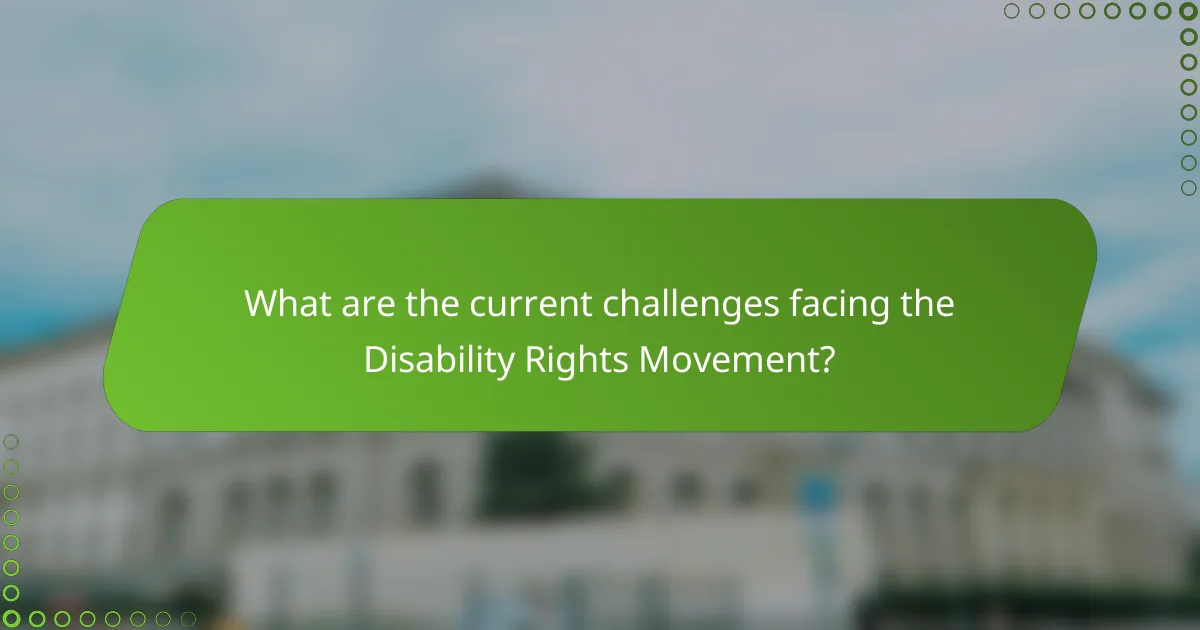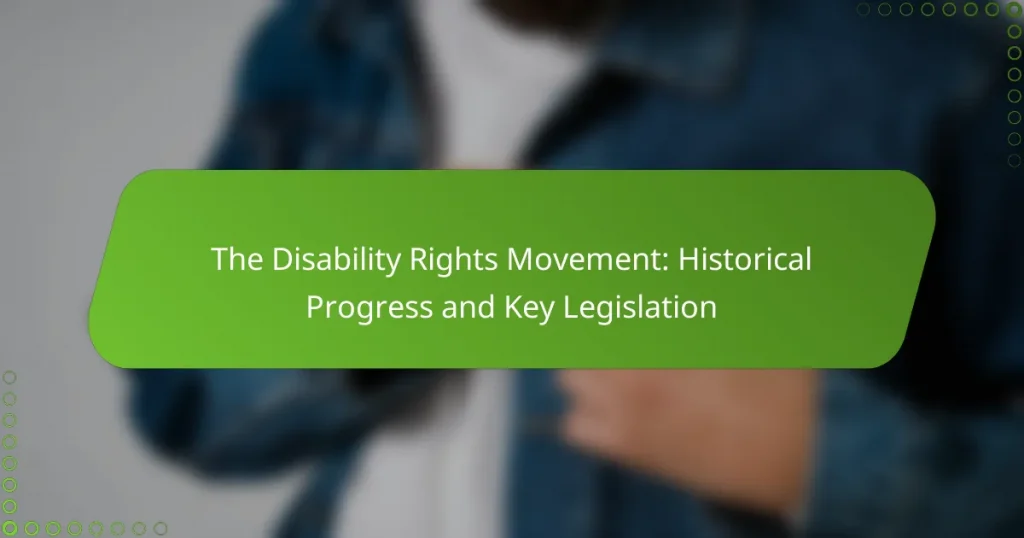The Disability Rights Movement is a social and political initiative focused on advocating for the rights and inclusion of individuals with disabilities. This movement seeks to eliminate discrimination and promote equal opportunities across various life domains, significantly influenced by the civil rights movements of the 1960s and 1970s. Key legislative milestones include the Americans with Disabilities Act (ADA) of 1990, which prohibits discrimination based on disability, and the Rehabilitation Act of 1973. Despite these advancements, ongoing challenges such as systemic discrimination, accessibility issues, and inadequate funding for services persist, necessitating continued advocacy for policy changes to enhance equality and awareness of disability rights.

What is the Disability Rights Movement?
The Disability Rights Movement is a social and political movement advocating for the rights and inclusion of individuals with disabilities. It seeks to eliminate discrimination and promote equal opportunities in various aspects of life. The movement gained momentum in the 1960s and 1970s, influenced by the civil rights movements. Key achievements include the Americans with Disabilities Act (ADA) of 1990, which prohibits discrimination based on disability. Advocacy efforts have led to increased accessibility in public spaces and services. The movement emphasizes the importance of self-advocacy and empowerment for individuals with disabilities. It continues to address ongoing challenges and promote awareness of disability rights.
How did the Disability Rights Movement begin?
The Disability Rights Movement began in the 1960s as a response to systemic discrimination against individuals with disabilities. Activists sought to challenge the societal norms that marginalized disabled people. Key events included the establishment of organizations like the National Federation of the Blind in 1940 and the formation of the Disability Rights Movement in the 1960s. The movement gained momentum through protests, advocacy, and legal challenges. The 1973 Rehabilitation Act marked a significant legislative victory, prohibiting discrimination based on disability in federally funded programs. This act laid the groundwork for future legislation, including the Americans with Disabilities Act of 1990. The movement continues to evolve, addressing ongoing issues of accessibility and inclusion.
What historical events contributed to the emergence of the Disability Rights Movement?
The emergence of the Disability Rights Movement was influenced by several key historical events. The post-World War II era saw an increase in awareness of disability issues due to veterans returning home with disabilities. In 1961, President John F. Kennedy’s administration initiated a focus on mental health, leading to increased advocacy. The Civil Rights Movement of the 1960s inspired disabled individuals to demand equal rights. The 1973 Rehabilitation Act marked a significant legislative milestone, prohibiting discrimination based on disability in federally funded programs. The 1990 Americans with Disabilities Act further solidified civil rights protections. These events collectively fostered a growing consciousness about disability rights.
Who were the key figures in the early stages of the Disability Rights Movement?
Key figures in the early stages of the Disability Rights Movement include Ed Roberts, Judy Heumann, and Justin Dart Jr. Ed Roberts is known for his advocacy for independent living and founded the first Center for Independent Living in Berkeley, California. Judy Heumann played a pivotal role in the 504 Sit-in in 1977, which protested against discrimination. Justin Dart Jr. is recognized for his efforts in the passage of the Americans with Disabilities Act (ADA) in 1990. These individuals significantly influenced the movement’s direction and achievements.
What are the core principles of the Disability Rights Movement?
The core principles of the Disability Rights Movement include equality, accessibility, and self-determination. Equality emphasizes that individuals with disabilities should have the same rights and opportunities as those without disabilities. Accessibility focuses on removing barriers in physical spaces, communication, and technology to ensure full participation. Self-determination asserts that people with disabilities have the right to make decisions about their own lives. These principles are rooted in the belief that disability is a natural part of human diversity. The movement has led to significant legislation, such as the Americans with Disabilities Act (ADA) of 1990, which enshrines these principles into law.
How do these principles advocate for equality and inclusion?
The principles of the Disability Rights Movement advocate for equality and inclusion by promoting equal access and opportunities for individuals with disabilities. These principles emphasize the right to participate fully in society without discrimination. Legislation such as the Americans with Disabilities Act (ADA) of 1990 exemplifies this advocacy. The ADA prohibits discrimination based on disability in various areas, including employment and public accommodations. This law has led to increased accessibility in buildings and transportation. Additionally, the principles support the idea that individuals with disabilities should have a voice in decisions affecting their lives. This empowerment fosters a more inclusive society where all individuals can thrive.
What role does self-advocacy play in the Disability Rights Movement?
Self-advocacy is crucial in the Disability Rights Movement as it empowers individuals with disabilities to express their needs and rights. This empowerment leads to increased visibility and representation in societal decision-making processes. Self-advocacy encourages individuals to challenge discrimination and advocate for policy changes. Historically, self-advocacy groups, like People First, emerged in the 1970s, promoting the idea that individuals with disabilities should speak for themselves. These groups have been instrumental in shaping legislation, such as the Americans with Disabilities Act (ADA) of 1990. The ADA was influenced by the self-advocacy movement, which highlighted the importance of accessible environments and equal rights. By asserting their voices, individuals with disabilities have significantly advanced the goals of the Disability Rights Movement.
What impact has the Disability Rights Movement had on society?
The Disability Rights Movement has significantly transformed societal perceptions and policies regarding disability. It has led to the enactment of crucial legislation, such as the Americans with Disabilities Act (ADA) of 1990. The ADA prohibits discrimination against individuals with disabilities in various areas, including employment and public accommodations.
This movement has also fostered greater awareness of accessibility issues. Public spaces are now more inclusive due to improved architectural standards. Educational institutions have implemented policies to support students with disabilities, ensuring equal access to education.
Moreover, advocacy efforts have empowered individuals with disabilities to assert their rights. This has resulted in increased representation in media and politics. The movement has also inspired global initiatives, influencing disability rights legislation in other countries.
Overall, the Disability Rights Movement has reshaped societal attitudes, promoting a more inclusive environment for individuals with disabilities.
How has public perception of disabilities changed due to the movement?
Public perception of disabilities has significantly improved due to the Disability Rights Movement. Increased visibility and advocacy have fostered greater awareness of the challenges faced by individuals with disabilities. Legislative changes, such as the Americans with Disabilities Act, have emphasized inclusion and accessibility. This legal framework has shifted societal attitudes toward acceptance and support. Public campaigns have highlighted the capabilities and contributions of people with disabilities. As a result, stereotypes have been challenged and dismantled. Studies show that more people now view disabilities as a part of human diversity rather than as limitations. Overall, the movement has transformed perceptions from pity to empowerment and equality.
What are the social and cultural implications of the Disability Rights Movement?
The Disability Rights Movement has significantly impacted social and cultural perceptions of disability. It has fostered greater awareness and understanding of disability rights. This movement has challenged societal norms that marginalize individuals with disabilities. It has promoted inclusivity and accessibility in various aspects of life, including education and employment. Legislation such as the Americans with Disabilities Act (ADA) has established legal protections against discrimination. This legal framework has encouraged cultural shifts toward acceptance and integration. The movement has also empowered individuals with disabilities to advocate for their rights. Overall, the Disability Rights Movement has reshaped societal attitudes, promoting dignity and equality for people with disabilities.

What key legislation has shaped the Disability Rights Movement?
The key legislation that has shaped the Disability Rights Movement includes the Americans with Disabilities Act (ADA) of 1990. The ADA prohibits discrimination against individuals with disabilities in various areas, including employment, public accommodations, and transportation. It established comprehensive civil rights protections for people with disabilities. Another significant piece of legislation is the Rehabilitation Act of 1973, which was the first federal law to address the rights of individuals with disabilities. Section 504 of this act prohibits discrimination in programs receiving federal funding. The Individuals with Disabilities Education Act (IDEA) of 1975 ensures that children with disabilities have the right to a free and appropriate public education. These laws collectively have advanced the rights and inclusion of individuals with disabilities in society.
What are the most significant laws related to disability rights?
The most significant laws related to disability rights include the Americans with Disabilities Act (ADA) of 1990. The ADA prohibits discrimination against individuals with disabilities in various areas such as employment, public services, and accommodations. Another key law is the Rehabilitation Act of 1973, which established the rights of individuals with disabilities to access federal programs. The Individuals with Disabilities Education Act (IDEA) ensures that children with disabilities receive a free appropriate public education. The Fair Housing Act also prohibits discrimination based on disability in housing. These laws collectively promote equality and accessibility for individuals with disabilities across multiple sectors.
How did the Americans with Disabilities Act (ADA) transform rights for people with disabilities?
The Americans with Disabilities Act (ADA) transformed rights for people with disabilities by prohibiting discrimination based on disability. This landmark legislation, enacted in 1990, provided comprehensive civil rights protections. It mandated equal access to public accommodations, employment, transportation, and telecommunications. The ADA established that individuals with disabilities have the same rights as those without disabilities. It also required reasonable accommodations in the workplace. The law has led to increased accessibility in buildings and services. According to the U.S. Department of Justice, the ADA has significantly improved the quality of life for millions of Americans with disabilities.
What other important legislation has been enacted to support disability rights?
The Americans with Disabilities Act (ADA) of 1990 is a key piece of legislation supporting disability rights. It prohibits discrimination against individuals with disabilities in various areas such as employment, public accommodations, and transportation. The Rehabilitation Act of 1973 also plays a significant role. It prohibits discrimination based on disability in federal programs and activities. The Individuals with Disabilities Education Act (IDEA) ensures that children with disabilities have access to free appropriate public education. The Fair Housing Act protects individuals with disabilities from discrimination in housing. These laws collectively establish crucial protections and rights for people with disabilities in the United States.
How has legislation evolved over time in relation to the Disability Rights Movement?
Legislation has evolved significantly over time in relation to the Disability Rights Movement. The movement gained momentum in the 1960s and 1970s, leading to critical legal changes. The Rehabilitation Act of 1973 was one of the first major laws prohibiting discrimination based on disability. This act established the foundation for future legislation by ensuring access to federal programs and services.
In 1990, the Americans with Disabilities Act (ADA) was enacted, providing comprehensive civil rights protections. The ADA prohibited discrimination in employment, public accommodations, and transportation. This landmark legislation represented a significant shift towards inclusion and equality for individuals with disabilities.
Subsequent amendments, like the ADA Amendments Act of 2008, further clarified and expanded the definition of disability. These changes aimed to protect more individuals from discrimination by broadening the criteria for what constitutes a disability.
Legislation continues to evolve, reflecting the ongoing advocacy and needs of the disability community. Current efforts focus on enhancing accessibility and addressing issues like healthcare and education. Overall, the evolution of legislation demonstrates a progressive commitment to civil rights for individuals with disabilities.
What changes have been made to existing laws to enhance protections for individuals with disabilities?
Significant changes have been made to existing laws to enhance protections for individuals with disabilities. The Americans with Disabilities Act (ADA) was amended in 2008 to broaden the definition of disability. This change ensures more individuals qualify for protections under the law. The amendments clarified that mitigating measures, such as medication, should not be considered when determining disability status. Additionally, the Individuals with Disabilities Education Act (IDEA) has been updated to improve access to education for students with disabilities. These updates include increased funding and support for special education services. The Rehabilitation Act was also strengthened to enhance employment opportunities for individuals with disabilities. These legislative changes reflect a commitment to advancing the rights and protections of individuals with disabilities.
How do international laws compare to U.S. legislation on disability rights?
International laws and U.S. legislation on disability rights differ in scope and enforcement. International laws, such as the Convention on the Rights of Persons with Disabilities (CRPD), emphasize a broad human rights framework. The CRPD promotes inclusion and accessibility globally. It requires countries to adopt measures that uphold the rights of individuals with disabilities.
In contrast, U.S. legislation, primarily the Americans with Disabilities Act (ADA), focuses on specific civil rights protections. The ADA prohibits discrimination based on disability in various areas, including employment and public accommodations. It mandates reasonable accommodations in the workplace and accessibility in public spaces.
While both frameworks aim to protect disability rights, the CRPD is more comprehensive in its global approach. The U.S. legislation is more focused on domestic application. Additionally, the CRPD has a stronger emphasis on the social model of disability, while U.S. laws often reflect a medical model perspective. This difference influences how disability rights are implemented and understood in practice.

What are the current challenges facing the Disability Rights Movement?
The current challenges facing the Disability Rights Movement include systemic discrimination, lack of accessibility, and inadequate funding for services. Systemic discrimination persists in employment and education, limiting opportunities for individuals with disabilities. Accessibility remains a significant issue, with many public spaces and transportation systems not fully compliant with accessibility standards. Funding for disability services is often insufficient, impacting the quality of support available. Additionally, the COVID-19 pandemic has exacerbated existing inequalities, revealing gaps in healthcare access for disabled individuals. Advocacy efforts continue to push for policy changes to address these challenges and promote equality.
What barriers still exist for individuals with disabilities today?
Barriers for individuals with disabilities today include physical accessibility issues, social stigma, and employment discrimination. Many public spaces remain inaccessible due to inadequate ramps, elevators, or signage. This limits mobility and participation in community activities. Social stigma often leads to negative stereotypes, impacting mental health and social inclusion. Employment discrimination persists, with many employers hesitant to hire individuals with disabilities. According to the U.S. Bureau of Labor Statistics, in 2021, the employment rate for people with disabilities was only 19.1%, compared to 63.7% for those without disabilities. These barriers highlight the ongoing challenges faced by individuals with disabilities in achieving full equality and participation in society.
How do economic factors impact the rights of people with disabilities?
Economic factors significantly impact the rights of people with disabilities. Limited financial resources can restrict access to necessary services and support. For instance, inadequate funding for disability programs can lead to reduced employment opportunities. This, in turn, affects the economic independence of individuals with disabilities. Economic constraints can also limit access to healthcare and rehabilitation services. According to the World Health Organization, individuals with disabilities are more likely to experience poverty. This economic disadvantage can perpetuate social exclusion and limit advocacy efforts for rights. Thus, economic factors play a crucial role in shaping the rights and opportunities available to people with disabilities.
What role does advocacy play in addressing current challenges?
Advocacy plays a crucial role in addressing current challenges within the Disability Rights Movement. It raises awareness about the issues faced by individuals with disabilities. Advocacy also influences policy changes to improve accessibility and rights. Organizations and activists mobilize communities to support legislative reforms. For example, the Americans with Disabilities Act (ADA) was a result of sustained advocacy efforts. These efforts highlight the need for equal opportunities and protections. Furthermore, advocacy provides a platform for disabled individuals to voice their experiences. This collective action fosters societal change and promotes inclusivity.
What strategies can be employed to further advance the Disability Rights Movement?
Advancing the Disability Rights Movement requires strategic advocacy, policy change, and public awareness. Grassroots organizing can mobilize individuals with disabilities to demand their rights. Coalition-building with other social justice movements strengthens collective efforts. Legislative advocacy is crucial for enacting laws that protect disability rights, such as the Americans with Disabilities Act. Public education campaigns can raise awareness about disability issues and combat stigma. Engaging in research to highlight the needs and experiences of people with disabilities informs policy decisions. Utilizing social media platforms amplifies voices and connects advocates nationwide. Finally, ensuring representation of disabled individuals in leadership roles promotes authentic advocacy.
How can individuals get involved in advocacy for disability rights?
Individuals can get involved in advocacy for disability rights by joining local organizations that focus on disability issues. These organizations often provide training and resources for effective advocacy. Volunteering for events and campaigns can raise awareness and support for disability rights. Engaging in social media campaigns amplifies the voices of individuals with disabilities. Attending public meetings and forums allows individuals to voice their concerns and influence policy. Contacting legislators to express support for disability rights legislation is crucial. Participating in awareness events, such as Disability Awareness Month, helps educate the public. Supporting businesses that prioritize accessibility promotes inclusivity in the community.
What best practices can organizations adopt to support the movement?
Organizations can adopt inclusive policies and practices to support the Disability Rights Movement. They should ensure accessibility in physical spaces and digital platforms. Training staff on disability awareness is essential. Collaborating with disability advocacy groups can amplify efforts. Providing reasonable accommodations for employees with disabilities fosters an inclusive environment. Regularly reviewing policies for compliance with legislation like the Americans with Disabilities Act is crucial. Engaging in community outreach can raise awareness and promote understanding. These practices not only support the movement but also enhance organizational culture and productivity.
How can we ensure the ongoing progress of the Disability Rights Movement?
To ensure the ongoing progress of the Disability Rights Movement, we must promote inclusive policies and legislation. Advocacy efforts should focus on enhancing accessibility in public spaces and workplaces. Education about disability rights is crucial for fostering societal understanding. Collaboration with disabled individuals in decision-making processes is essential. Funding for disability-related programs must be increased to support initiatives. Regular assessments of existing laws can identify gaps needing attention. Engaging allies from various sectors can amplify the movement’s impact. Historical successes, like the Americans with Disabilities Act, demonstrate the importance of sustained efforts.
What are the most effective ways to raise awareness about disability rights?
Effective ways to raise awareness about disability rights include education, advocacy, and community engagement. Education can involve workshops, seminars, and school programs that inform people about disability rights and issues. Advocacy efforts can include campaigns and partnerships with organizations that focus on disability rights. Community engagement fosters inclusive events that highlight the experiences of individuals with disabilities. Social media campaigns can also amplify messages and reach broader audiences. Research shows that 70% of people are more likely to support disability rights after being informed through educational initiatives.
How can education and community engagement contribute to the movement’s success?
Education and community engagement are essential for the success of the Disability Rights Movement. Education raises awareness about disability rights and promotes understanding of the challenges faced by individuals with disabilities. It equips advocates with knowledge about legal protections and available resources. Community engagement fosters solidarity and collective action among individuals, families, and allies. This collaboration amplifies voices and strengthens advocacy efforts. Historical evidence shows that informed communities have successfully lobbied for legislation like the Americans with Disabilities Act. Engaged citizens can mobilize support, leading to policy changes and improved accessibility. Thus, education and community engagement are foundational to advancing the movement’s goals.
The Disability Rights Movement is a social and political initiative advocating for the rights and inclusion of individuals with disabilities, aiming to eliminate discrimination and promote equal opportunities. The movement gained traction in the 1960s and 1970s, leading to significant legislative milestones such as the Rehabilitation Act of 1973 and the Americans with Disabilities Act (ADA) of 1990. Key figures like Ed Roberts and Judy Heumann played pivotal roles in shaping the movement, which emphasizes core principles of equality, accessibility, and self-determination. Current challenges include systemic discrimination and accessibility issues, while ongoing advocacy efforts aim to address these barriers and promote further legislative advancements.




